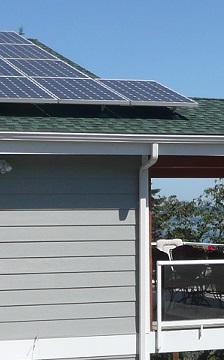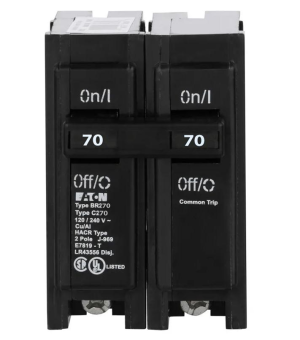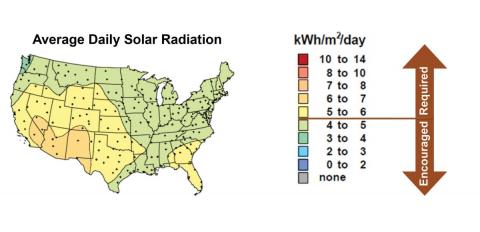Scope
To construct a home that is prepared for the installation of a future solar photovoltaic (PV) system:
- Include a dedicated 70-amp dual-pole circuit breaker.
- Place the circuit breaker panel box near the future balance of system components for the PV.
- Consider space requirements and layout within the home and on the roof for solar photovoltaic system components early in the design process.
See the Compliance Tab for links to related codes and standards and voluntary federal energy-efficiency program requirements.
Description
A renewable energy-ready home (RERH) is one that is built with the wiring and plumbing conduit and other components in place to facilitate the future installation of solar photovoltaic (PV) panels and/or solar water heating panels. Some energy-efficiency programs, like the U.S. Department of Energy’s DOE Zero Energy Ready Home Program, require homes to be renewable-energy ready.
To prepare for a future PV system to be connected in a home, install a dedicated double-pole circuit breaker in the electrical service panel or in a separate subpanel. The breaker is intended for protection of the PV modules and wiring from reverse current flow. The breaker should be appropriately sized for the PV array that is being installed.
How to Install a 70-Amp Dual-Pole Circuit Breaker
- To meet the requirements of the DOE Zero Energy Ready Home program, designate a dedicated space in the electrical service panel for a dual-pole circuit breaker.
- Hire a licensed electrician certified by the local jurisdiction to install the electrical equipment associated with the electrical service panel.
- Label each breaker in the service panel with water-resistant labels. The breakers dedicated for the future PV system should read, “Renewable Energy Ready Home – Solar PV Dedicated Breaker.” See Figure 1.
- Record the location of the future PV system and all of its components on relevant architectural diagrams to be provided to the homeowner.
Success
Ensure adequate space in the electrical service panel for a dedicated dual-pole breaker, early in the design process. If possible, place the circuit breaker panel box near the future balance of system components for the PV. Confirm with local code officials early in the design process what steps are needed to guarantee that installation of PV panels will meet with local codes, homeowner's association covenants, and historic district regulations.
Protect the electrical and mechanical components of the PV system from bulk moisture, high temperatures, and direct sunlight. The utility room should be properly ventilated and maintain average indoor temperatures. Proper clearances and working spaces should also be maintained.
Climate
The DOE Zero Energy Ready Home PV-Ready Checklist (Revision 07) is required only under the following condition related to climate (See the Compliance Tab for other exceptions):
- Location, based on zip code, has at least 5 kWh/m2/day average daily solar radiation based on annual solar insolation using the PVWatts online tool. See map below.
Training
Compliance
Retrofit
For a gut rehab where the objective is to renovate the home to meet the criteria of the DOE Zero Energy Ready Home program or a similar program that requires the home to be ready for the installation of solar panels, follow the new home guidance provided in the Description tab.
For a renovation that includes installation of photovoltaic solar panels on an existing home, verify with the panel installer that the electrical panel has sufficient space and backfeed protection for the photovoltaic system desired.
More
More Info.
Access to some references may require purchase from the publisher. While we continually update our database, links may have changed since posting. Please contact our webmaster if you find broken links.
The following authors and organizations contributed to the content in this Guide.
Building Science Corporation, lead for the Building Science Consortium (BSC), a DOE Building America Research Team
Pacific Northwest National Laboratory
Sales
Solar Electric Ready Home = Solar Electric Ready Home

As solar photovoltaic (PV) panels have significantly come down in price, many homeowners are installing them to produce clean power and reduce their electric bills. Many more homeowners are likely to want this option for the future. Solar electric-ready homes make this possible with minimal to no disruption or cost penalty using simple no-cost/low-cost details and best practices integrated during construction. This includes ensuring adequate unshaded roof space for the PV panels, installing conduit from the attic to the electric service panel, securing documentation that the roof is designed to support the extra weight of the PV array, and providing adequate space near the electrical panel for balance of system components.


